Transverse aeolian ridges
Transverse aeolian ridges (TARs) are visually bright features commonly found in topographic depressions on Mars.[1][2][3] These small-scale and relict bedforms were first seen in narrow-angle images from the Mars Orbiter Camera (MOC)[2][3] and were called “ridges” to preserve both dunes and ripples as formative mechanisms.[2][3] While TARs are widespread on Mars, their formation, age, composition, and role in past Martian sediment cycles remain poorly constrained.[1][2][4][5][6][7]
Aeolian bedforms
Aeolian bedforms are typically classified into either ripples or dunes based on their morphologies and formative mechanisms. Dunes are larger (>0.5 m or taller on Earth[8]), typically asymmetrical in cross-profile, and are the product of hydrodynamic instability related to sand flux, the local topography, shear stress exerted by the wind on sand grains,[9] and flow-form interactions induced by the topography of the dune itself.[10][11][12][13] Wind ripples by comparison are small (amplitudes of 0.6 - 15 mm[14][15][16][17]), are more symmetrical in profile, and are created by saltating and repeating sand grains that tend for form a regular pattern of impact and shadow zones.[8][12][16][17]
On Mars, TARs represent some intermediate form with characteristics of both ripples and dunes. TARs are typically symmetrical in profile[18][19] similar to wind ripples. However, TARs are several orders of magnitude larger than wind ripples observed on Mars or Earth.[20][21][22] TARs are much smaller than Martian dunes, do not have slip-faces, and do not have the characteristic dune stoss and leeslopes. Furthermore, while TARs and dunes have approximately basaltic signatures on Mars,[23] TARs have lower thermal inertias than dunes,[24] indicating that TARs on their surfaces are composed of smaller particles than dunes.[25] Some features on Earth have been proposed as proxies for TARs: gravel megaripples in Argentina,[26][27] megaripples in Iran[28] and Libya,[29] and reversing dunes in Idaho,[30] but an exact analog remains elusive.
Morphologies
TARs also exhibit a range of morphologies, which are interpreted as representing different formative and evolutionary processes.[2] Past efforts have been made to categorize TAR with classification systems primarily focusing on crest morphology.[2][3]
| Morphology | Description | Example image | HiRISE image source |
|---|---|---|---|
| Simple | Straight parallel crests |  |
https://www.uahirise.org/ESP_045814_1520 |
| Forked | Straight parallel crests with forking |  |
https://www.uahirise.org/ESP_045814_1520 |
| Sinuous | Winding but non-overlapping crests |  |
https://www.uahirise.org/PSP_002824_1355 |
| Barchan-like | Relatively short crests bent at ~90-150º |  |
https://www.uahirise.org/ESP_036410_1810 |
| Networked | Highly connected ridge crests that form closed irregular polygonal shapes |  |
https://www.uahirise.org/PSP_002824_1355 |
| Feathered[2][31][32]* | Large primary ridge with smaller secondary ridges approximately perpendicular to the main crest |
*Established in the literature but not recognized as a distinct morphology
Formation
There are competing hypotheses for TAR formation.[2][19][26][28][29][30][33][34] Granule ripples covered by a monolayer of coarse millimeter-sized particles have been proposed for smaller TARs (amplitude <1 m),[22][33][35][36] while dust-covered reversing dunes have been proposed for TARs >1 m in amplitude.[37][30]
Past climate
Understanding TAR formation and evolution could offer insight into the winds that created them.[38] In turn, these inferences could have further insights into past wind patterns, atmospheric compositions, and climatic dynamics generally on Mars.[38] Relict aeolian features exist on Earth and are useful records of local and atmospheric conditions, but the rapid erosion rates on Earth erase aeolian features older than the approximately the Last Glacial Maximum.[39][40][41][42] Resurfacing rates are much slower on Mars so TARs could preserve conditions considerably further back in the Martian past.
Current activity
A 2020 study found evidence that some isolated TARs could still be minimally active (i.e. ridge crests that are moving or changing), but the literature suggests that the majority of TARs are immobile.[43] For example, dunes have been observed passing over TARs with no change to the underlying TARs after the dune's passing.[1][2]
Images of TARs
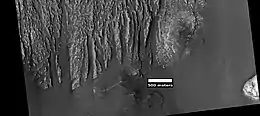 Yardangs, as seen by HiRISE under HiWish program. Location is Arsinoes Chaos. The next image shows part of this enlarged so that TAR's can be seen.
Yardangs, as seen by HiRISE under HiWish program. Location is Arsinoes Chaos. The next image shows part of this enlarged so that TAR's can be seen.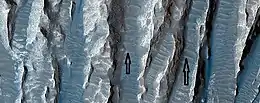 Close-up of yardangs, as seen by HiRISE under HiWish program. Arrows point to sand ridges that are called "transverse aeolian ridges" (TAR's).
Close-up of yardangs, as seen by HiRISE under HiWish program. Arrows point to sand ridges that are called "transverse aeolian ridges" (TAR's). Layers in depression in crater, as seen by HiRISE under HiWish program A special type of sand ripple called Transverse aeolian ridges, TAR's are visible and labeled. Location is Hellas Planitia in Noachis quadrangle.
Layers in depression in crater, as seen by HiRISE under HiWish program A special type of sand ripple called Transverse aeolian ridges, TAR's are visible and labeled. Location is Hellas Planitia in Noachis quadrangle.
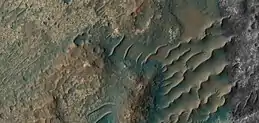 Close, color view of unusual transverse aeolian ridges, TAR's, as seen by HiRISE under HiWish program These features may have had variable local winds to make the wavy tops.
Close, color view of unusual transverse aeolian ridges, TAR's, as seen by HiRISE under HiWish program These features may have had variable local winds to make the wavy tops.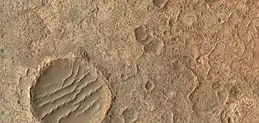 Close view of TAR's with waves, as seen by HiRISE under HiWish program
Close view of TAR's with waves, as seen by HiRISE under HiWish program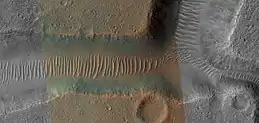 Close, color view of TAR's in a channel,as seen by HiRISE under HiWish program Only part of the image is in color because HiRISE only takes a 1 km wide color strip.
Close, color view of TAR's in a channel,as seen by HiRISE under HiWish program Only part of the image is in color because HiRISE only takes a 1 km wide color strip.
See also
References
- Berman, Daniel C.; Balme, Matthew R.; Rafkin, Scot C.R.; Zimbelman, James R. (2011). "Transverse Aeolian Ridges (TARs) on Mars II: Distributions, orientations, and ages". Icarus. 213 (1): 116–130. Bibcode:2011Icar..213..116B. doi:10.1016/j.icarus.2011.02.014. ISSN 0019-1035.
- Balme, Matt; Berman, Daniel C.; Bourke, Mary C.; Zimbelman, James R. (2008). "Transverse Aeolian Ridges (TARs) on Mars". Geomorphology. 101 (4): 703–720. Bibcode:2008Geomo.101..703B. doi:10.1016/j.geomorph.2008.03.011. ISSN 0169-555X.
- Wilson, Sharon A. (2004). "Latitude-dependent nature and physical characteristics of transverse aeolian ridges on Mars". Journal of Geophysical Research. 109 (E10): E10003. Bibcode:2004JGRE..10910003W. doi:10.1029/2004JE002247. ISSN 0148-0227.
- Bridges, N. T.; Bourke, M. C.; Geissler, P. E.; Banks, M. E.; Colon, C.; Diniega, S.; Golombek, M. P.; Hansen, C. J.; Mattson, S.; McEwen, A. S.; Mellon, M. T. (2012). "Planet-wide sand motion on Mars". Geology. 40 (1): 31–34. Bibcode:2012Geo....40...31B. doi:10.1130/G32373.1. ISSN 0091-7613.
- Geissler, Paul E.; Wilgus, Justin T. (2017). "The morphology of transverse aeolian ridges on Mars". Aeolian Research. 26: 63–71. Bibcode:2017AeoRe..26...63G. doi:10.1016/j.aeolia.2016.08.008.
- Geissler, Paul E. (2014). "The birth and death of transverse aeolian ridges on Mars: Transverse Aeolian Ridges on Mars". Journal of Geophysical Research: Planets. 119 (12): 2583–2599. doi:10.1002/2014JE004633.
- Wilson, Sharon A. (2015), "Transverse Aeolian Ridge (TAR)", in Hargitai, Henrik; Kereszturi, Ákos (eds.), Encyclopedia of Planetary Landforms, New York, NY: Springer, pp. 2177–2185, doi:10.1007/978-1-4614-3134-3_380, ISBN 978-1-4614-3134-3, retrieved 2020-09-16
- Vriend, N. M.; Jarvis, P. A. (2018). "Between a ripple and a dune". Nature Physics. 14 (7): 641–642. Bibcode:2018NatPh..14..641V. doi:10.1038/s41567-018-0113-0. ISSN 1745-2473. S2CID 125921951.
- WILSON, IAN G. (1972). "Aeolian Bedforms-Their Development and Origins". Sedimentology. 19 (3–4): 173–210. Bibcode:1972Sedim..19..173W. doi:10.1111/j.1365-3091.1972.tb00020.x. ISSN 0037-0746.
- Cooper, William S. (1958), "Coastal Sand Dunes of Oregon and Washington", 72 : Coastal Sand Dunes of Oregon and Washington, Geological Society of America Memoirs, vol. 72, Geological Society of America, pp. 1–162, doi:10.1130/mem72-p1, hdl:2027/osu.32435000785121, retrieved 2020-09-15
- G. Kocurek, M. Townsley, E. Yeh, K. (1992). "Dune and Dune-Field Development on Padre Island, Texas, with Implications for Interdune Deposition and Water-Table-Controlled Accumulation". SEPM Journal of Sedimentary Research. 62. doi:10.1306/d4267974-2b26-11d7-8648000102c1865d. ISSN 1527-1404.
{{cite journal}}: CS1 maint: multiple names: authors list (link) - Bagnold, R. A. (2012). Physics of Blown Sand and Desert Dunes. Dover Publications. ISBN 978-1-306-35507-0. OCLC 868966351.
- Werner, B. T. (1995). "Eolian dunes: Computer simulations and attractor interpretation". Geology. 23 (12): 1107–1110. Bibcode:1995Geo....23.1107W. doi:10.1130/0091-7613(1995)023<1107:EDCSAA>2.3.CO;2. ISSN 0091-7613.
- Anderson, R (1990). "Eolian ripples as examples of self-organization in geomorphological systems". Earth-Science Reviews. 29 (1–4): 77–96. doi:10.1016/0012-8252(0)90029-U.
- Boulton, J. Wayne (1997). Quantifying the morphology of aeolian impact ripples formed in a natural dune setting. National Library of Canada = Bibliothèque nationale du Canada. OCLC 654186636.
- Sharp, Robert P. (1963). "Wind Ripples". The Journal of Geology. 71 (5): 617–636. Bibcode:1963JG.....71..617S. doi:10.1086/626936. ISSN 0022-1376. S2CID 225043269.
- Wang, Peng; Zhang, Jie; Huang, Ning (2019). "A theoretical model for aeolian polydisperse-sand ripples". Geomorphology. 335: 28–36. Bibcode:2019Geomo.335...28W. doi:10.1016/j.geomorph.2019.03.013.
- Zimbelman, J. R.; Williams, S. H. (2007-07-01). "An Evaluation of Formation Processes for Transverse Aeolian Ridges on Mars". Seventh International Conference on Mars. 1353: 3047. Bibcode:2007LPICo1353.3047Z.
- Shockey, K. M.; Zimbelman, J. R. (2012-09-20). "Analysis of transverse aeolian ridge profiles derived from HiRISE images of Mars". Earth Surface Processes and Landforms. 38 (2): 179–182. doi:10.1002/esp.3316. ISSN 0197-9337. S2CID 128455414.
- Bourke, M.C.; Balme, M.; Beyer, R.A.; Williams, K.K.; Zimbelman, J. (2006). "A comparison of methods used to estimate the height of sand dunes on Mars". Geomorphology. 81 (3–4): 440–452. Bibcode:2006Geomo..81..440B. doi:10.1016/j.geomorph.2006.04.023. ISSN 0169-555X.
- Claudin, Philippe; Andreotti, Bruno (2006). "A scaling law for aeolian dunes on Mars, Venus, Earth, and for subaqueous ripples". Earth and Planetary Science Letters. 252 (1–2): 30–44. arXiv:cond-mat/0603656. Bibcode:2006E&PSL.252...30C. doi:10.1016/j.epsl.2006.09.004. ISSN 0012-821X. S2CID 13910286.
- Williams, S. H.; Zimbelman, J. R.; Ward, A. W. (2002). "Large Ripples on Earth and Mars". Lunar and Planetary Science Conference. 33: 1508. Bibcode:2002LPI....33.1508W.
- Fenton, Lori K.; Bandfield, Joshua L.; Ward, A. Wesley (2003). "Aeolian processes in Proctor Crater on Mars: Sedimentary history as analyzed from multiple data sets". Journal of Geophysical Research: Planets. 108 (E12): 5129. Bibcode:2003JGRE..108.5129F. doi:10.1029/2002je002015. ISSN 0148-0227.
- Fenton, Lori K.; Mellon, Michael T. (2006). "Thermal properties of sand from Thermal Emission Spectrometer (TES) and Thermal Emission Imaging System (THEMIS): Spatial variations within the Proctor Crater dune field on Mars". Journal of Geophysical Research. 111 (E6): E06014. Bibcode:2006JGRE..111.6014F. doi:10.1029/2004je002363. ISSN 0148-0227.
- Presley, Marsha A.; Christensen, Philip R. (1997-03-25). "Thermal conductivity measurements of particulate materials 1. A review". Journal of Geophysical Research: Planets. 102 (E3): 6535–6549. Bibcode:1997JGR...102.6535P. doi:10.1029/96JE03302.
- de Silva, S. L.; Spagnuolo, M. G.; Bridges, N. T.; Zimbelman, J. R. (2013-10-31). "Gravel-mantled megaripples of the Argentinean Puna: A model for their origin and growth with implications for Mars". Geological Society of America Bulletin. 125 (11–12): 1912–1929. Bibcode:2013GSAB..125.1912D. doi:10.1130/b30916.1. ISSN 0016-7606.
- Montgomery, David R.; Bandfield, Joshua L.; Becker, Scott K. (2012). "Periodic bedrock ridges on Mars". Journal of Geophysical Research: Planets. 117 (E3): n/a. Bibcode:2012JGRE..117.3005M. doi:10.1029/2011je003970. ISSN 0148-0227.
- Foroutan, M.; Zimbelman, J.R. (2016). "Mega-ripples in Iran: A new analog for transverse aeolian ridges on Mars". Icarus. 274: 99–105. Bibcode:2016Icar..274...99F. doi:10.1016/j.icarus.2016.03.025. ISSN 0019-1035.
- Foroutan, M.; Steinmetz, G.; Zimbelman, J.R.; Duguay, C.R. (2019). "Megaripples at Wau-an-Namus, Libya: A new analog for similar features on Mars". Icarus. 319: 840–851. Bibcode:2019Icar..319..840F. doi:10.1016/j.icarus.2018.10.021. ISSN 0019-1035. S2CID 125750298.
- Zimbelman, James R.; Scheidt, Stephen P. (2014). "Precision topography of a reversing sand dune at Bruneau Dunes, Idaho, as an analog for Transverse Aeolian Ridges on Mars". Icarus. 230: 29–37. Bibcode:2014Icar..230...29Z. doi:10.1016/j.icarus.2013.08.004. ISSN 0019-1035.
- Berman, Daniel C.; Balme, Matthew R.; Michalski, Joseph R.; Clark, Stacey C.; Joseph, Emily C.S. (2018). "High-resolution investigations of Transverse Aeolian Ridges on Mars". Icarus. 312: 247–266. Bibcode:2018Icar..312..247B. doi:10.1016/j.icarus.2018.05.003. S2CID 125348147.
- Bhardwaj, Anshuman; Sam, Lydia; Martin-Torres, F. Javier; Zorzano, Maria-Paz (2019). "Distribution and Morphologies of Transverse Aeolian Ridges in ExoMars 2020 Rover Landing Site". Remote Sensing. 11 (8): 912. Bibcode:2019RemS...11..912B. doi:10.3390/rs11080912. ISSN 2072-4292.
- Hugenholtz, Chris H.; Barchyn, Thomas E.; Boulding, Adam (2017). "Morphology of transverse aeolian ridges (TARs) on Mars from a large sample: Further evidence of a megaripple origin?". Icarus. 286: 193–201. Bibcode:2017Icar..286..193H. doi:10.1016/j.icarus.2016.10.015. ISSN 0019-1035.
- Montgomery, David R.; Bandfield, Joshua L.; Becker, Scott K. (2012). "Periodic bedrock ridges on Mars". Journal of Geophysical Research: Planets. 117 (E3): n/a. Bibcode:2012JGRE..117.3005M. doi:10.1029/2011je003970. ISSN 0148-0227.
- Lämmel, Marc; Meiwald, Anne; Yizhaq, Hezi; Tsoar, Haim; Katra, Itzhak; Kroy, Klaus (2018-04-30). "Aeolian sand sorting and megaripple formation". Nature Physics. 14 (7): 759–765. Bibcode:2018NatPh..14..759L. doi:10.1038/s41567-018-0106-z. ISSN 1745-2473. S2CID 125706603.
- Wilson, S. A.; Zimbelman, J. R.; Williams, S. H. (2003-03-01). "Large Aeolian Ripples: Extrapolations from Earth to Mars". Lunar and Planetary Science Conference. 34: 1862. Bibcode:2003LPI....34.1862W.
- Zimbelman, James R. (2010). "Transverse Aeolian Ridges on Mars: First results from HiRISE images". Geomorphology. 121 (1–2): 22–29. Bibcode:2010Geomo.121...22Z. doi:10.1016/j.geomorph.2009.05.012. ISSN 0169-555X.
- Gardin, Emilie; Allemand, Pascal; Quantin, Cathy; Silvestro, Simone; Delacourt, Christophe (2012). "Dune fields on Mars: Recorders of a climate change?". Planetary and Space Science. Titan Through Time: A Workshop on Titan’s Formation, Evolution and Fate. 60 (1): 314–321. Bibcode:2012P&SS...60..314G. doi:10.1016/j.pss.2011.10.004. ISSN 0032-0633.
- BEVERIDGE, CARRIE; KOCUREK, GARY; EWING, RYAN C.; LANCASTER, NICHOLAS; MORTHEKAI, P.; SINGHVI, ASHOK K.; MAHAN, SHANNON A. (2006). "Development of spatially diverse and complex dune-field patterns: Gran Desierto Dune Field, Sonora, Mexico". Sedimentology. 53 (6): 1391–1409. Bibcode:2006Sedim..53.1391B. doi:10.1111/j.1365-3091.2006.00814.x. ISSN 0037-0746. S2CID 129496135.
- KOCUREK, GARY; HAVHOLM, KAREN G.; DEYNOUX, MAX; BLAKEY, RONALD C. (1991). "Amalgamated accumulations resulting from climatic and eustatic changes, Akchar Erg, Mauritania". Sedimentology. 38 (4): 751–772. Bibcode:1991Sedim..38..751K. doi:10.1111/j.1365-3091.1991.tb01018.x. ISSN 0037-0746.
- Swezey, Christopher S. (2003). "Late Pleistocene and Holocene dune activity and wind regimes in the western Sahara Desert of Mauritania: Comment and Reply". Geology. 31 (1): e18. doi:10.1130/0091-7613-31.1.e18. ISSN 1943-2682.
- Wolfe, Stephen A.; Huntley, David J.; Ollerhead, Jeff (2006-07-18). "Relict Late Wisconsinan Dune Fields of the Northern Great Plains, Canada*". Géographie Physique et Quaternaire. 58 (2–3): 323–336. doi:10.7202/013146ar. ISSN 1492-143X.
- Silvestro, S.; Chojnacki, M.; Vaz, D. A.; Cardinale, M.; Yizhaq, H.; Esposito, F. (2020). "Megaripple Migration on Mars". Journal of Geophysical Research: Planets. 125 (8): e2020JE006446. Bibcode:2020JGRE..12506446S. doi:10.1029/2020JE006446. ISSN 2169-9097. PMC 7583471. PMID 33133993.